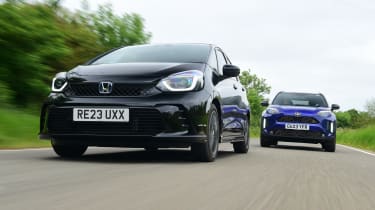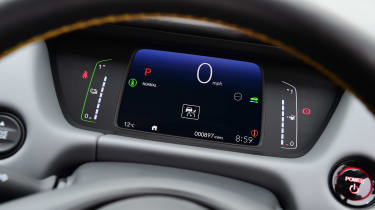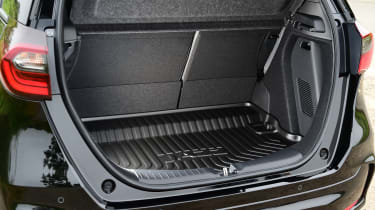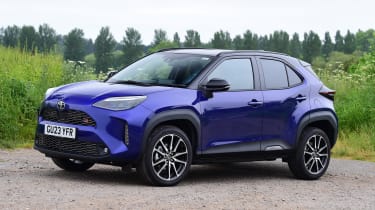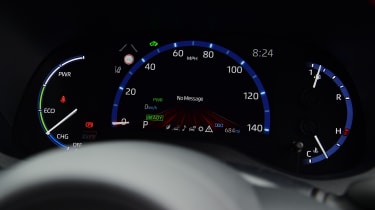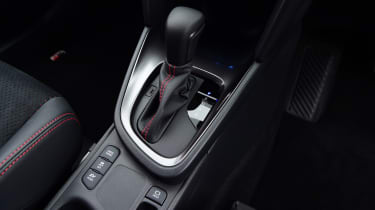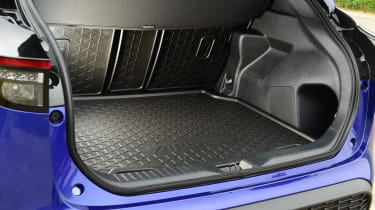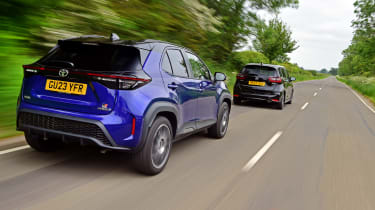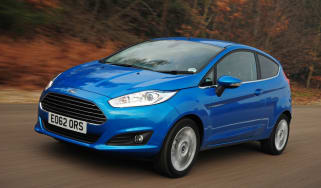Honda Jazz vs Toyota Yaris Cross: 2023 twin test review
The updated Honda Jazz now comes in Sport guise. Is it any more fun than the Toyota Yaris Cross GR Sport?
Many car manufacturers have tried to make their mainstream models more appealing by giving them a sporty update. The latest recipient is the Honda Jazz. The Jazz Sport comes as part of an overhaul of the range that included the addition of a more powerful hybrid system, yet one that offers the same economy as before.
But is the Sport badge misleading? To find out, we’ve lined the Jazz up against the Toyota Yaris Cross GR Sport. This small SUV is in a different sector, but is priced similarly to the Jazz, while its GR badges tie it to Toyota’s motorsport programme. So which model is the most appropriately titled?
|
Honda Jazz Sport |
Toyota Yaris Cross GR Sport | |
|
Price: |
£28,145 |
£29,480 |
|
Powertrain: |
1.5-litre 4cyl hybrid, 106bhp/2x electric motors, 120bhp |
1.5-litre 3cyl hybrid, 90bhp/1x electric motor, 79bhp |
|
0-62mph: |
9.6 seconds |
11.2 seconds |
|
Test efficiency: |
58.5mpg/12.9mpl |
47.2mpg/10.4mpl |
|
CO2: |
105g/km |
112g/km |
|
Annual VED: |
£170 |
£170 |
Honda Jazz
The fourth-generation Honda Jazz (known as the Honda Fit in Japan and other regions) arrived in 2020, and with it came a solitary hybrid powertrain option. Now Honda has increased system output and added the Sport model as the flagship of the range. It starts from £28,145.
Tech highlights
While Honda hasn’t been as all-embracing of hybrid drive as Toyota, it’s making up for it now with some clever tech. The e:HEV-branded hybrid system in the Jazz features two electric motors, one that drives the front wheels, the other acting as a generator, while a 1.5-litre four-cylinder petrol engine supplements the pair of them.
Another big difference is that the electric motors match or surpass the petrol engine for power output. For the 2023 update, Honda has boosted the petrol engine (a modest 9bhp increase to 106bhp), the generator (up by 11bhp to 105bhp) and the drive motor (a 13bhp boost to 121bhp), and yet the Jazz’s economy and emissions figures are unchanged.
There are tweaks to the CVT system, too, which are designed to improve its responses, with the Sport model featuring unique settings that are meant to make it feel more responsive still. It also features stiffer front suspension and firmer dampers all round to boost its handling.
Styling updates have also been introduced, with the ‘bullnose’ look of lower-spec models dropped in favour of a more conventional grille, while the Sport model adds a sharper front bumper, mesh grille design and unique 16-inch alloy wheels.
Safety: Honda’s Sensing safety system has been tweaked, too. There’s a wider-angle front camera to monitor the road ahead for the brake-assist and lane-departure tech, while the systems have been revised to be less intrusive, too. More on that later.
On the road
The Jazz is at its best at lower speeds, but it doesn’t lose its composure the faster you go. An agile chassis is a pleasant surprise, too.
Around town: Light steering and an agile chassis mean the Honda Jazz is well suited to urban life and it’s easy to manoeuvre. The electric motors boost the car’s responses when pulling away, while the powertrain favours electric drive the majority of the time. This is indicated by a green ’EV’ logo that illuminates on the dashboard.
The car’s ride is a little on the firm side, but it’s not harsh. The Jazz has three levels of regenerative braking, although none of them is particularly strong.
A & B-roads: Pick up the pace, and the Jazz is still pretty decent, with quick steering helping to deliver responsive handling in corners, and the relatively firm suspension helping to mitigate body roll.
However, the Jazz isn’t a car that encourages you to press on, and that’s down to the character of the hybrid powertrain. Apply any more than two-thirds throttle and the CVT sends the engine’s revs soaring, which results in plenty of noise, but not much additional forward motion. The engine settles quickly once you lift off, but you soon get used to being gentler with the accelerator to let the electric motors do most of the work.
Motorway: At higher speeds, the Jazz is comfortable and stable, and cruising at 70mph is no problem at all. One interesting feature of the hybrid powertrain is how often it operates in electric mode; even in the 60-70mph range, the green EV light illuminates, where the Toyota’s petrol engine is constantly running. Sure, the Honda’s engine cuts in as soon as you touch the throttle, but that EV running will help with fuel economy.
Ownership
While the Honda Jazz Sport attempts to inject a bit of racy style into the supermini package, there’s no shying away from the fact that the Jazz appeals to an older demographic with its comfort, layout and user-friendliness. The doors open wide, the seats have a wide range of adjustment and support, and there’s a clear view of your surroundings.
The cabin finish is decent, with high-quality plastics and solid switchgear, including user-friendly buttons on the multifunction steering wheel. The two-tone colours of the interior help to give things a lift, while the Sport model includes part-artificial leather upholstery and Alcantara-style trim that adds to the upmarket cabin feel.
As we mentioned before, there are plenty of driver-assistance systems in the Jazz, but while Honda claims that they are less intrusive than before, they still make their presence felt. The lane-assist function is especially strong; switch lanes on the motorway without indicating, and the wheel will tug in your hands to keep you in the lane you’re leaving, which can be a little disconcerting. However, at least the system’s alarms are easy to deactivate, because the Yaris Cross is even more frustrating in that regard.
The Jazz has a three-year/90,000-mile warranty, while the Yaris Cross matches it at three years, but has a 30,000-mile limit. However, Toyota offers up to 10 years/100,000 miles of warranty cover if you get the car serviced at a main dealer.
Practicality: As well as the clever Magic Seats, the Jazz has plenty of cabin storage. There’s a twin glovebox in front of the passenger, shallow cup-holders at either end of the dashboard and long door bins, too. The rear door pockets are slightly smaller, but still have room for bottles.
There’s no storage under the central armrest, but there’s a deep tray beneath, and space for a smartphone below the twin USB sockets.
Practicality
Inclusion of Magic Seats means the Jazz is very versatile for its size.
Rear Space: Surprisingly, there’s more legroom in the back of the Jazz than there is in the Yaris Cross. Headroom and shoulder space are slightly behind, but it’s not tight if there are two in the back, while passengers also benefit from twin USB-C ports; the Toyota doesn’t offer any charging sockets in the rear.
Boot: The Jazz’s party trick is its Magic Seats, so while the 304-litre boot trails the Yaris Cross’s by almost 100 litres, the back seats have flip-up bases to create a second storage area with a flat floor.
The seat bases fall forward when you fold the 60:40-split backs to create a completely flat space, too, and the total capacity of 1,205 litres is more than 100 litres up on the Toyota, demonstrating the extra passenger space that the Jazz has to offer.
What to buy?
Which engine and trim we’d choose
- Engines: The only powertrain offered in the Jazz is the hybrid 1.5 e:HEV set-up.
- Trim: The range kicks off with the basic Elegance, then there’s well equipped Advance and off-road-styled Crosstar variants before you get to the top-spec Sport model tested here.
- Options: Aside from different paints, all that’s offered are personalisation options, with exterior trim packs, different alloy-wheel designs, a tow-bar preparation, interior LED lighting, cabin colour packs and extra kit to make the most of the boot space on offer.
- Our choice: Advance trim has all the kit you’ll need for less than Crosstar or Sport versions
Toyota Yaris Cross
The Yaris Cross has been a decent seller for Toyota, and the company has now expanded the line-up with a racier GR Sport flagship. Priced at £29,480, it costs £1,335 more than the Jazz, but in reality, it sits in a different class from the supermini. Does it justify the extra outlay? And do the GR Sport upgrades do the badge justice?
Tech highlights
With GR Sport versions of the Corolla, C-HR, Yaris and even the Hilux pick-up truck already in existence, it was largely inevitable that the Yaris Cross would benefit from the same treatment. However, the updates are more than just a cosmetic makeover.
The visual changes include the addition of a new 18-inch wheel design, while a black contrast roof has been added, and metallic paint is standard. There’s a black mesh grille, a diffuser-style rear bumper and the all-important GR Sport badges are added to the nose and tail. Inside, suede-effect upholstery and red stitching are added along with more GR logos, while an eight-speaker JBL stereo is also included.
Under the skin, the suspension, featuring MacPherson struts up front and a torsion beam rear axle, has been retuned to deliver sharper responses and better resistance to roll.
The hybrid powertrain remains unchanged. It comprises a 1.5-litre three-cylinder petrol engine and a single electric motor, and there’s a combined system output of 114bhp. Honda doesn’t quote such an output for the Jazz, but both its engine and electric motor are more powerful.
Safety: These two are closely matched in terms of Euro NCAP scores, with both achieving a five-star rating. The Yaris Cross has an advantage for child occupant and safety-assist scores, but the Jazz is ahead for adult occupants and pedestrian safety.
On the road
There’s a sporty edge to the Yaris Cross that does justice to the GR Sport badge, but it’s to the detriment of passenger comfort.
Around town: As with the Jazz, the Yaris Cross favours electric drive at lower speeds, but the engine is keener to cut in when accelerating. That’s not too much of an issue, though, because while the three-cylinder unit sounds gruffer than the Honda’s engine, it’s not as loud and it’s in keeping with the racy character the GR Sport is supposed to have.
One area where the Yaris Cross disappoints is its low-speed ride. The car fidgets most of the time, and it’s a situation that’s exacerbated by the stiffer set-up of the GR Sport. The taller seating position does at least offer a better view ahead, but it’s not head and shoulders above the Jazz.
Toyota offers a ‘B’ mode to boost engine braking when lifting off the throttle. It’s stronger than the Honda’s system, but the car’s engine tends to fire up more often in this mode, which cancels out the benefits of the additional energy recovery.
A & B-roads: When the road gets twisty, the Yaris Cross feels pretty agile, with direct steering and sharper responses than the Honda, while body roll is kept in check. The trade-off for this agility is that the ride remains on the firm side, and is harsher at speed than it is around town.
Motorway: As with the Jazz, the Yaris Cross uses its electric motor to fill in the power band as the petrol engine gets up to speed, but the Toyota’s cabin is better insulated from engine noise, so it doesn’t sound as harsh. Once you’re at motorway pace, the engine remains active most of the time where the Honda is more inclined to shut its petrol unit down wherever possible.
Ownership
One benefit that the Yaris Cross has over its Jazz rival is its accessibility. The car’s 170mm ground clearance is 24mm higher than the Honda’s, but that means the seat bases are higher, which will make it easier for occupants to get in and out. It’s one of the things that has made SUVs so appealing.
One downside of a raised ride height is a taller load lip, but the Yaris Cross mitigates this in other ways, by having a level floor and a wider opening tailgate that, unlike the Jazz, doesn’t require you to step back as it opens.
Hybrid drive helps to reduce the company-car costs of these two, but the Honda’s lower list price and emissions offer significant savings over the Toyota. A CO2 figure of 105g/km puts it in the 25 per cent Benefit-in-Kind band, compared with 27 per cent for the Yaris Cross, which emits 112g/km in GR Sport spec. That means annual savings of £182 a year for lower-rate users.
Economy: Adding hybrid drive to a small car is designed to boost fuel efficiency when compared with a pure-petrol model, and we returned decent fuel figures for both cars on test.
Our driving included some longer stints on the motorway, and in that instance, the Honda’s electrical system puts in more effort than the Toyota’s set-up. So while there’s around 5mpg difference in the official WLTP economy figures of both cars, we managed to stretch that to a 10mpg gap, returning 58.5mpg in the Jazz and 48.7mpg in the Yaris Cross. Keep to lower speeds around town and the Jazz will easily exceed the 60mpg mark, because it uses electric drive more often than the Yaris Cross.
You’ll also be able to go further between fills courtesy of the Honda’s larger fuel tank. According to our figures, a range of more than 500 miles is possible, but the tiny 36-litre tank in the Yaris Cross pegs it back to less than 400 miles on a single fill.
Practicality
The Yaris Cross’s larger body benefits boot space more than rear-passenger room.
Rear Space: The Toyota has a 40mm longer wheelbase than the Jazz, but the extra length doesn’t translate into extra space in the back seats, because there’s less legroom here than in the Honda.
Headroom is better – although the Jazz isn’t cramped in that regard – while the back seats are wider, although it’ll still be cosy for three. The dark interior colours make it feel more claustrophobic, and there’s a lack of power connectors, too.
Boot: Toyota does add a 12-volt socket in the boot, while the shape of the cargo area is squarer than the Honda’s. A 60:40-split false floor creates additional storage space beneath it that measures 120mm deep, although the boards do feel a little flimsy. The rubber boot protector in our pictures comes as standard with GR Sport models.
What to buy?
Which engine and trim we’d choose
- Engines: As with the Honda Jazz, there’s just one powertrain available in the UK, the 1.5-litre hybrid tested here.
- Trim: There are four levels on offer – Icon, Design, Excel and GR Sport. There’s a difference of £6,630 between the cheapest and most expensive models.
- Options: Four-wheel drive can be added to Excel trim for £2,360, a Tech Pack adds the GR Sport’s infotainment to Design trim for £500, while a panoramic roof is offered on Excel and GR Sport cars for £330. Excel cars have an Advanced Safety Pack as standard, but it’s £650 extra on GR Sport.
- Our choice: A Design-spec model with the Tech Pack offers the best value of the range
Results
Which car comes out on top?
Winner: Honda Jazz
The Jazz squeezes a narrow victory here, thanks to its lower everyday running costs, smarter hybrid tech and very clever interior layout. It also fits the brief of the Sport badge better than the Yaris Cross, but only just.
However, there are drawbacks. As a supermini, it’s very expensive, and you can get a genuinely entertaining model for the same money. The Jazz makes a lot more sense in a lower spec – you’ll get the same innovative fuel-saving tech and cabin layout, while not feeling short-changed in terms of kit.
|
Pros |
Cons |
|
Clever hybrid technology |
Expensive |
|
Excellent fuel economy |
Not that sporty |
|
Smart Magic Seats layout |
Messy infotainment |
|
Agile handling |
Intrusive safety systems |
Runner up: Toyota Yaris Cross
Given that it’s in a different class, it seems unfair to place the Yaris Cross second here. But as with the Jazz, it’s a car that makes more sense in a lower specification. The GR Sport looks the part, but the revisions don’t make it any more sportier than the standard model, apart from giving it a more unsettled ride.
It’s surprising that the Yaris Cross doesn’t offer quite as much room as the Jazz in the back, and while it has a bigger boot, its seat folding and cabin storage aren’t as innovative.
|
Pros |
Cons |
|
Smooth hybrid powertrain |
Over-sensitive safety kit |
|
Good visibility |
Tight back seats |
|
Easy-access cabin |
Lack of power |
|
Generous boot |
Overly firm ride |
Rivals and other options
- Same class: Ford Puma ST-Line
- Same money: Hyundai i20 N
- Used: Renault Captur
- Used: Skoda Enyaq iV
- Coming soon: BYD Dolphin
The great debate
What the Auto Express test team would do…
Sean Carson, associate editor: “Manufacturers have always built sporty-looking cars that offer a racier look, but with no added performance. It’s a real shame that neither Honda nor Toyota has gone the extra step and given these two some extra power to go with their sportier looks.”
John McIlroy, deputy editor: “There was a time when the Type R badge was offered on more cars than just the Civic hot hatch. The Jazz Sport is only 100mm shorter than the original Japan-only Civic Type R, and the agile chassis certainly feels as if it could cope with more power. Maybe it’s time for a hybrid hot supermini?”
Dawn Grant, picture editor: “While these two cars are from different classes, it’s surprising how close they are in terms of practicality. You could even choose one over the other depending on your needs; if boot capacity is more important than rear-seat space, choose the Toyota, and vice versa if passengers are your priority.”
Steve Fowler, editor-in-chief: “It’s been more than 20 years since we first saw Honda’s Magic Seats appear in the Jazz, and I’m surprised that no other manufacturer has offered a similar solution. The flexibility on offer – without the need to remove them completely – is something that’s still attractive today.”
Alex Ingram, chief reviewer: “The Toyota’s large, square boot offers more space than the Honda’s in five-seat mode, but the lightweight floorboards don’t feel particularly strong, while the fabric load cover is another disappointment. Take it off and it feels like it’ll blow away on a windy day.”
What would you do? Let us know in the comments section below…
Specs and prices
|
Honda Jazz 1.5 i-MMD Sport |
Toyota Yaris Cross 1.5 VVT-i GR Sport | |
|
Petrol or diesel |
Petrol |
Petrol |
|
MPG (WLTP) |
58.5 |
48.7 |
|
Fuel price |
£1.43 |
£1.43 |
|
P11D value |
£27,915 |
£29,225 |
|
Fill up |
£57.24 |
£51.51 |
|
On the road price/total as tested |
£28,145 / £28,145 |
£29,480 / £29,480 |
|
Residual value (after 3yrs/36,000) |
£15,081 (56.1%) |
£18,012 (61.1%) |
|
Depreciation |
£12,344 |
£11,468 |
|
Annual tax liability std/higher rate |
£1,395.75 / £2,791.50 |
£1,578.15 / £3,156.30 |
|
Annual fuel. cost (10k/20k miles) |
£1,334 (£2,224) |
£1,603 (£2,672) |
|
Ins. group/quote/VED |
N/A/N/A/£170 |
12/N/A/£170 |
|
Service costs (3 years) |
£285/£355/£335 |
£27 per month (36 months) |
|
Length/wheelbase |
4,089/2,517mm |
4,180/2,560mm |
|
Height/width |
1,526/1,814mm |
1,595/1,765mm |
|
Powertrain |
4cyl in-line/1,498cc |
3cyl in-line/1,490cc |
|
Peak power/ revs |
106bhp/6,000rpm |
90bhp/5,500rpm |
|
Peak torque/ revs |
131Nm/4,500rpm |
120Nm/3,600rpm |
|
Transmission |
CVT auto/fwd |
CVT auto/fwd |
|
Fuel tank capacity / spare wheel |
40 litres |
36 litres |
|
Boot capacity (front / seats up/down) |
304/1,205 litres |
397/1,097 litres |
|
Kerbweight/payload/towing weight |
1,244/442/500kg |
1,360/415/550kg |
|
Turning circle |
10.7 metres |
11.2 metres |
|
Basic warranty/recovery |
3yrs (90k)/3yrs |
3yrs (60k)/1yr |
|
Driver Power manufacturer position |
5th |
10th |
|
Euro NCAP: Adult/child/ped./assist/stars |
87/83/80/76/5 (2020) |
86/84/78/81/5 (2021) |
|
0-62mph/top speed |
9.6 secs/108mph |
11.2 secs/106mph |
|
WLTP economy / range |
58.5/515 |
48.7/386 |
|
WLTP combined |
61.4mpg |
57.6mpg |
|
Actual/claimed CO2/tax bracket |
112/105g/km / 25% |
134/112g/km / 27% |
|
Number of airbags/Isofix points |
Nine/two |
Nine/two |
|
Parking sensors/camera |
F&r/yes |
£650 pack/yes |
|
Lane-keep assist/blindspot/AEB |
Yes/yes/yes |
Yes/£650 pack/yes |
|
Climate control/ adaptive cruise ctrl |
Yes/yes |
Two-zone/yes |
|
Leather/heated seats/wheel |
Part faux/yes/yes |
No/yes/no |
|
Metallic paint/LED lights |
£650/yes |
Yes/yes |
|
Keyless entry & go/powered tailgate |
Yes/no |
Yes/no |
|
Sat-nav/digital dashboard |
Yes/part faux |
Yes/part faux |
|
Online services/wireless charging/USBs |
Yes/no/four |
Yes/no/one |
|
Apple CarPlay/Android Auto |
Wireless/yes |
Wireless/wireless |

